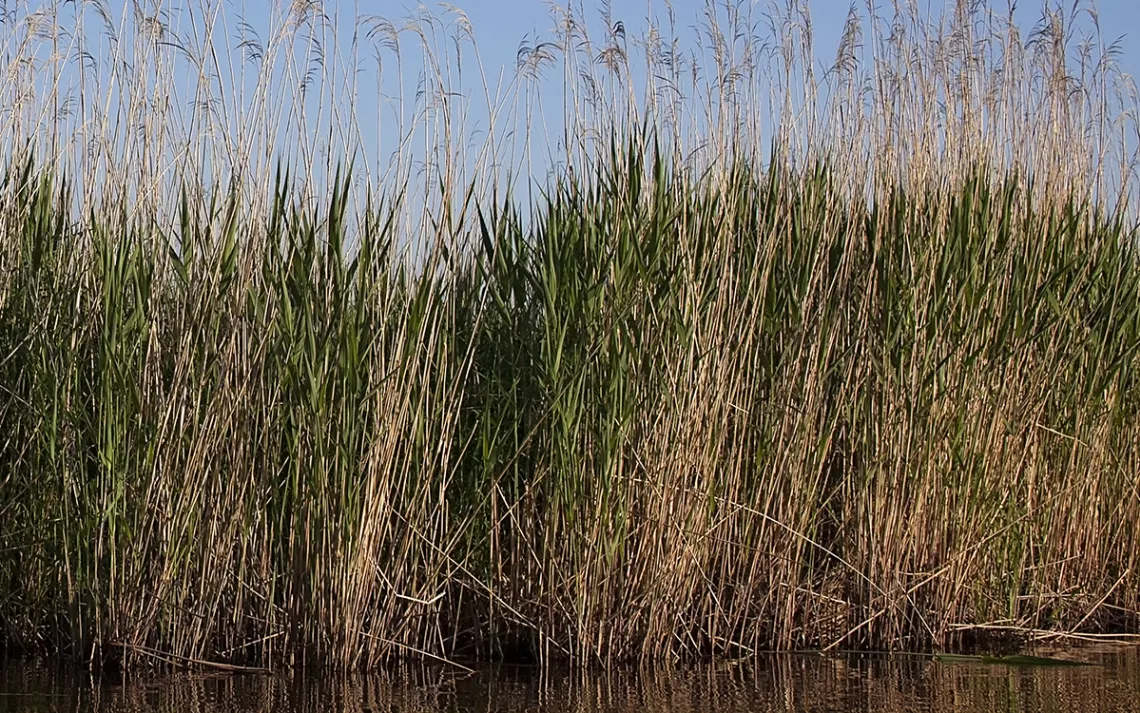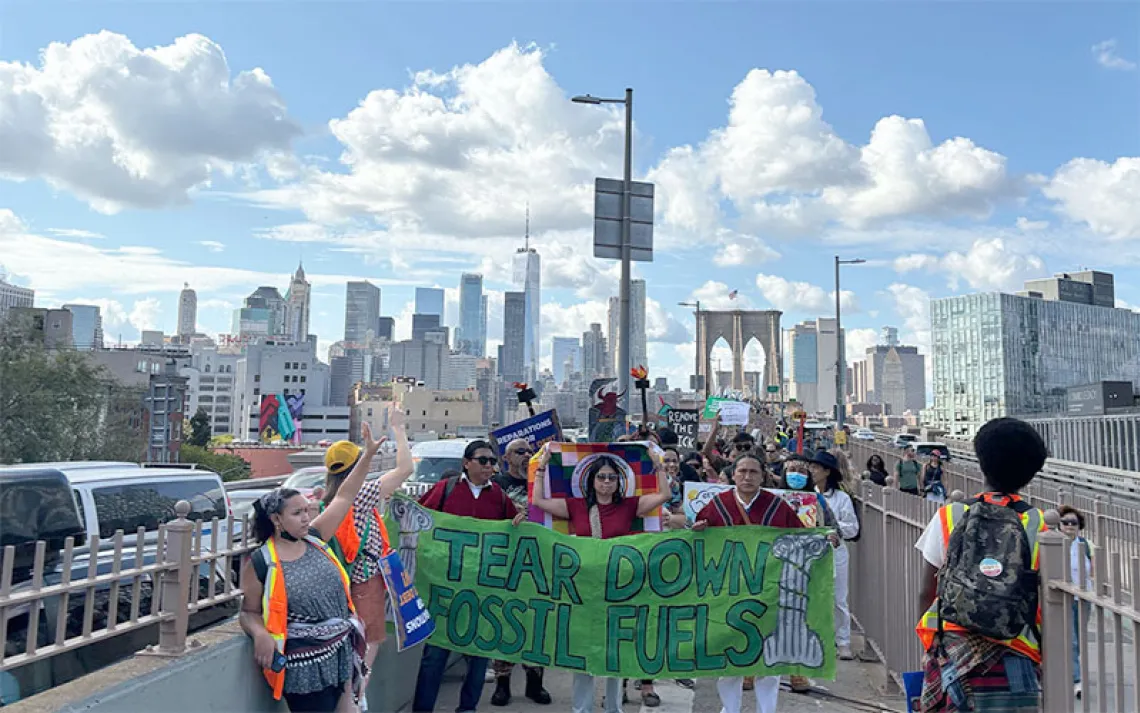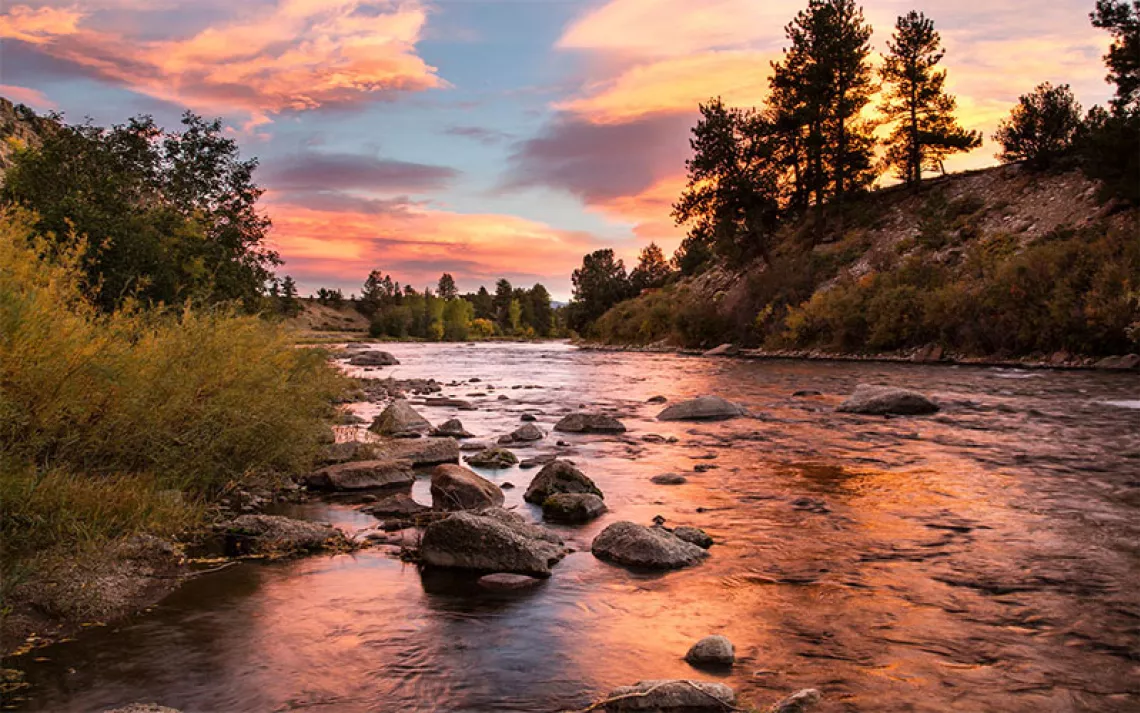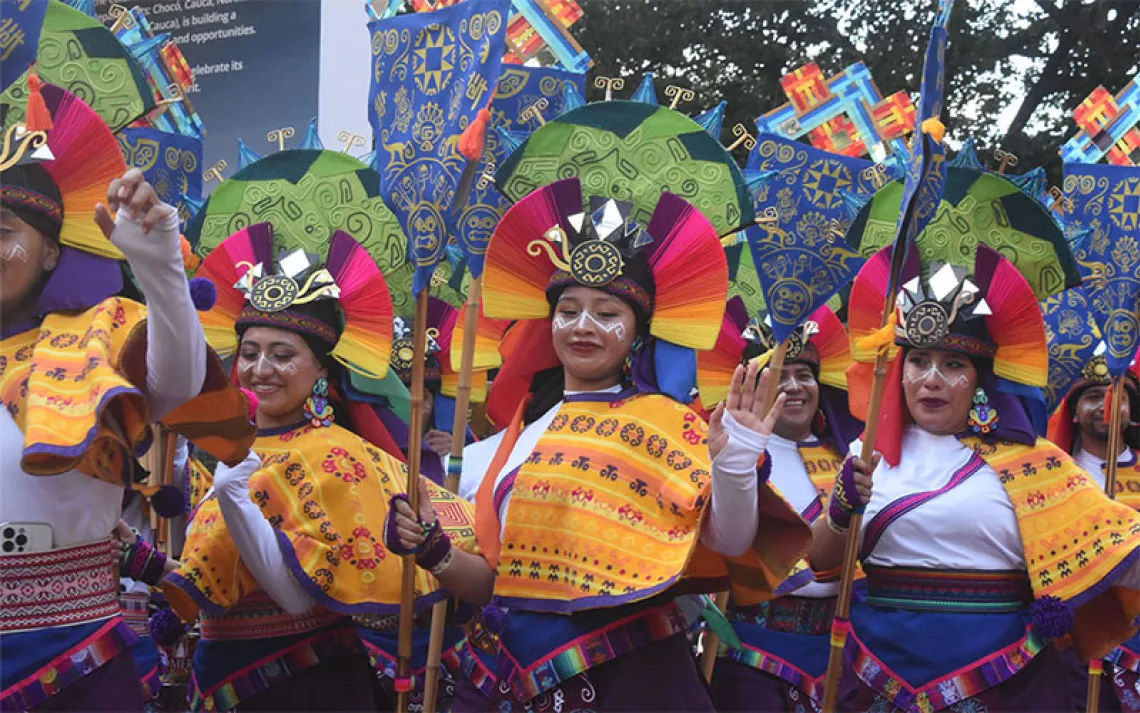“Like Gold to Us”: Native American Nations Struggle to Protect Wild Rice
Mines, pipelines, warming temperatures threaten a staple of Indigenous identity

Photo by Lynn_Bystrom/iStock
When Dylan Jennings, a member of the Bad River Band of the Ojibwe, was a child, he and his family loaded on canoes to prowl the waters of northern Wisconsin, looking for the wispy beds of wild rice.
“I remember rice being all over the sloughs, and my family would harvest wild rice,” said Jennings, 27, now a Bad River elected tribal council member. “We spent days ricing and ricing, and when the sloughs were done, we would go to the inland lakes to look for rice. Back then, wild rice was more plentiful and healthier.”
Now, the wild rice that Jennings’s family and other tribal members rely on as an integral part of their diet is becoming less abundant. “As I get older, there’s not nearly as many wild rice beds as there used to be,” Jennings said. “I’m seeing a lot of brown spot disease, and even our elders say that they don’t see rice beds or the wildlife of rice beds like they used to anymore.”
The wild rice, called manoomin in the Ojibwe language, is native to the lakes and rivers of the Great Lakes region and Canada. Once as plentiful as grass itself, wild rice—which grows on long, delicate stalks—was easily found along rivers, sloughs, and lakes throughout the North Woods. Manoomin was such a stable part of many Native American nations’ diets that it had an honored place in cultural and religious ceremonies as well as some groups’ origin stories.
But the rice is at risk from a range of threats. Rising temperatures caused by greenhouse gas emissions is shrinking its range, as are dams, which have converted flowing rivers to reservoirs that aren’t ideal habitat. Mining operations could potentially poison some rice-growing areas. At the same time, homeowners in some locations have fought against Indigenous efforts to seed rice along the ponds and lakes.
“If you look at Wisconsin’s state history, there used to be rice beds in the southern part of the state. They don’t exist anymore. Now you only find it in the northern part,” Jennings said. “That is an alarming thing.” He continued, “It would be very hard for our community to fathom life without wild rice. Beyond being a food source, it allows us to reconnect with our environment. Our whole way of life is associated with wild rice.”

Harvesting manoomin is a cultural tradition that goes back centuries and is still practiced today, much in the same way it was done before Europeans set foot in North America. In Minnesota, each summer members of the White Earth Nation navigate their canoes through the shallows of Upper and Lower Rice Lake to collect the rice, which is packed with protein, is low in fat, and has a higher nutritional value than other grains. Harvesters pull the rice stalks over their canoes and scrape the thin, wispy stalks with traditionally designed “knockers.” The grains—some dark and earthy, others obsidian black—fall to the bottom of the boats and then are gathered by hand. Once a canoe is full, the harvesters pull up to the shore to bag the raw rice and sell it to the White Earth Band, which distributes the rice to tribal members for consumption and ceremonial uses. Anything left over is sold at the White Earth Wild Rice store and online.
“The rice we purchase comes from our [tribal] members,” said Tracy Goodwin, manager of White Earth Wild Rice, which distributes and sells the grain. “They drag their canoes up to the shores, and we buy the rice right there. We can have 50 to 100 people lined up to sell the rice they harvest. I wish there were even more.”
In an effort to increase rice yields, the White Earth Band over the years has reseeded lakes and waterways where wild rice has grown historically. But Goodwin insists the rice is still wild—and of a completely different character from cultivated rice varieties. “Cultivated wild rice is a totally different product,” she said. “We don’t cultivate rice or introduce it to lakes that did not originally have wild rice beds. If you taste cultivated wild rice and native wild rice, it’s so completely different. We taste cultivated wild rice and we cringe.”
That deep cultural connection to wild rice is under threat by, among other things, fossil fuel development. In Minnesota, the White Earth Band of Ojibwe is fighting a proposal by Canadian energy infrastructure firm Enbridge to replace its Line 3 pipeline, which carries crude oil from Canada to the United States. Tribal members worry that any pipeline leak or rupture could pollute the rice beds. “With the pipeline possibly moving in, we worry,” Goodwin said. “If it gets anywhere near our water, it could contaminate our plants. We want to make sure it remains natural. We want to keep chemicals away from it.”
In their effort to halt pipeline construction, Ojibwe members have spoken against the proposal at official hearings, staged protests and marches, and engaged in civil disobedience actions. In December 2018, the White Earth Band passed a tribal law that establishes legal personhood for wild rice—including the right to “flourish, regenerate, and evolve.”
Meanwhile, in Wisconsin, the Bad River Band of the Lake Superior Tribe of Chippewa Indians is trying to stop another Enbridge project, the Line 5 pipeline, which would move oil from Canada through Wisconsin and into Michigan. A spill in the region could be devastating for rice-growing areas, said Jennings, who also serves as a spokesperson for the Great Lakes Indian Fish and Wildlife Commission. The area is famous for its wild rice harvest, and Jennings said a spill in the area would devastate the ecosystems. “The Bad River in northern Wisconsin has a unique and nationally recognized watershed and estuary,” he said. “It’s also one of the only areas that has wild rice growing right on Lake Superior. From the tribe’s perspective, industrialization and encroachment are huge threats to our water and air quality standards and how it correlates to the survival of wild rice.”
Tribal nations in the Great Lakes region have also fought against several proposed mines that, they say, could compromise water quality and put manoomin at risk. In 2015, the Bad River Band won a major battle when mining company Gogebic Taconite scrapped its plans to build a $1.5 billion iron-ore mine in Wisconsin’s Northwoods. The decision followed an independent environmental assessment conducted by local scientists from nearby Northland College, who worked with the Ojibwe to map out all the potential hazards to the environment and wild rice beds. In the course of the struggle, the Ojibwe often referred to their 1855 treaty with the United States, which guaranteed tribal members the right to hunt, fish, and gather on the proposed mine site.
Currently, the Menominee Indian Tribe of Wisconsin is fighting against the Back Forty Mine, a proposed open pit metallic sulfide mine located on the banks of the Menominee River in Lake Township, Michigan. Once again, the possible pollution of waterways that are home to wild rice is among the top concerns.

Beyond the immediate threats of industrial encroachment, warming temperatures and extreme weather events connected to climate change represent a looming danger for native manoomin. In 2018, the Great Lakes Indian Fish and Wildlife Commission released a “Climate Change Vulnerability Assessment” report that, among other things, investigated what effect climate change has had on wild rice. Of the 11 plant, animal, bird, and aquatic species studied, manoomin was found to be the most vulnerable; wild rice “has already begun to respond to climate-related effects,” the researchers wrote. Peter David, a wildlife biologist who has worked with the fish and wildlife commission for more than 30 years studying manoomin, said the native plant was already stressed due to decades of draining and damming waterways in the area—and that climate change is worsening the situation.
“Climate change is having a big effect, especially on northern wild rice, which has adapted to the harsh northern conditions,” he said. “It doesn’t do well in warmer conditions, so the warming trends are really bad for the plant. Add in the dramatic rains and storms we’ve been having with more frequency and the rice can also be drowned out. These 100-year storms are now coming every four years.”
“Wild rice is like gold for us,” Goodwin of White Earth Wild Rice said. "We never know what the harvest will be like with all these bad storms and weather. I always wonder, ‘Will we have enough to fulfill our community’s needs.'”
According to David, warmer temperatures in the region have also increased instances of brown spot disease, a fungal infection. “On top of that, more people on the lakes want pretty lakes,” he said. “They don’t want a bunch of rice beds mucking up their lakes.”
Indeed. Across the border in Canada, another battle over wild rice has been brewing for more than a decade, as First Nations there struggle with some white Canadians over how, or whether, to seed lakes and ponds with manoomin. Nearly 40 years ago, James Whetung, an Anishinaabe member and owner and operator of Black Duck Wild Rice, began sowing wild rice seeds in the waters surrounding the Curve Lake First Nation. In the early 1900s, the completion of dams and flooding of the water systems to create the Trent-Severn Waterway almost eradicated the wild rice in the area, and Whetung hoped to return wild rice to the First Nations along the Kawartha Lakes region east of Toronto. Whetung had learned the traditional practices of gathering, winnowing, curing, and roasting wild rice, and he was committed to making sure manoomin survived.
“The knowledge holders of our culture and ancient technologies were dying. My uncles would go to the few places where wild rice remained,” he said. “Thirty-six years ago, my father, two of my brothers, and I responded to a call to action from Ardock, a little settlement north of Sharbot Lake.”
That call to action sparked a conflict between the Anishinaabe and local white and Metis (people of mixed Indigenous and European ancestry) property owners. When Whetung began reseeding Pigeon Lake in the Curve Lake region, not everyone was happy. Vacation-home owners (often referred to as “cottagers” in Canada) noticed increasing wild rice beds along the shoreline and worried that Whetung’s efforts would reduce the enjoyment of boating on the lake—along with their property values.
The cottagers formed a Save Pigeon Lake group in 2007, saying Whetung’s efforts have made it impossible for them to travel the lake by boat or swim because the wild rice is clogging up the lake and the shorelines. They also say Whetung’s motorized airboat causes noise pollution and complain that the harvesting of rice causes masses of rice stalk to gather along the shoreline, forcing property owners to use their own money to clean it up. So far, numerous community meetings with local and provincial government officials have not yielded any resolution.
Whetung said he will continue to reseed the lake, even if the government tries to stop him. “The battle with a municipality or individuals and interest groups has no significance to me,” he said. “This is about food security and sovereignty for Anishinaabek nations. The decimation of wild rice and the destruction of our traditional foods has not only happened at Curve Lake—it has happened to all First Nations in Ontario. Cottagers are going to have to relinquish their privilege. This conflict is not about me.”
Whetung continued, “First Nations have been using the waters for thousands of years. Our connection to the land and to the waters is unerasable. For us, the disconnection is genocide.”
 The Magazine of The Sierra Club
The Magazine of The Sierra Club



